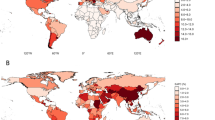Abstract
This study replicates a previous finding forthe U.S. counties that showed a strongassociation, net of controls between``structural pluralism'' and lower mortality. ``Structural pluralism'' refers to a community'scapacity for political competition, and is acore element of ``democracy.'' Pluralism hasthis effect because it facilitates theacquisition of appropriate medical facilitiesand because it tends to optimize the biologicalfunctioning of the residents. Working from amajor component of pluralism, minorityparticipation, this hypothesis is tested byshowing that women's status in less developedcountries improves life expectancy net ofcontrols. A path analysis demonstrates thatthe structural dimensions work through healthorganization as an intervening variable, andthe future testing of biological optimizationis outlined. Location in Africa south of theSahara is a partially unexplained controlvariable that has a powerful negative impact. Interpreting women's status as a component ofpluralism explains why it predicts increasedlife expectancy for all citizens, not justwomen. It is a global dimension that affectsall the members of a community.
Similar content being viewed by others
REFERENCES
Adler, N. E. and J. M. Ostrove: 1999, 'SES and health: what we know and what we don't know', in N. E. Adler, M. Marmot, B. S. McEwen and J. Stewart (eds.), Socioeconomic Status and Health in Industrial Nations: Social, Psychological and Biological Pathways (Annals of the New York Academy of Science, Bethesda, MD), pp. 3-15.
Arbuckle, J. L. and W. Wothke: 1999, Amos 4.0 Users Guide (SPSS Inc., Chicago).
Berkman, L. F. and T. Glass: 2000, 'Social integration, social networks, social support, and health,' in L. F. Berkman and I. Kawachi (eds.), Social Epidemiology (Oxford University Press, New York), pp. 137-173.
Boehmer, U. and J. B. Williamson: 1996, 'The impact of women's status on infant mortality rate: A cross-national analysis', Social Indicators Research 37, pp. 333-360.
Bollen, K. A. and R. W. Jackman: 1985, 'Political democracy and the size distribution of income', American Sociological Review 50, pp. 438-457.
Caldwell, J. C.: 1986, 'Routes to low mortality in poor countries', Population and Development Review 6, pp. 225-255.
Caldwell, J. C.: 1993, 'Health transition: The cultural, social and behavioural determinants of health in the third world',Social Science and Medicine 36, pp. 125-135.
Caldwell, J. C.: 1994, 'How is greater maternal education translated into lower child mortality?', Health Transition Review 4, pp. 224-229.
Durkheim, E.: 1951/1897, Suicide (The Free Press Glencoe, IL).
Evans, R. G., M. L. Barer and T. R. Marmor: 1994, Why are Some People Healthy and Others Not? (Aldine de Gruyter, New York).
Frey, R. S. and A. Al-Roumi.: 1999, 'Political democracy and the physical quality of life: The cross-national evidence', Social Indicators Research 47, pp. 73-97.
Gastil, R. D.: 1990, Freedom in the World: Political Rights and Civil Liberties, 1990–1991 (Greenwood Press, New York).
Kawachi, I., B. P. Kennedy, V. Gupta and D. Prothrow-Stith: 1999, 'Women's status and health of women and men: A view from the states', Social Science and Medicine 48, pp. 21-32.
Kawachi, I., B. P. Kennedy and and R. G. Wilkinson (eds.): 1999, Income Inequality and Health. The Society and Population Health Reader (The New Press, New York).
Nathanson, C. A.: 1995, 'Mortality and the position of women in developed countries', in A. D. Lopez, G. Caselli and T. Valkonen (eds.), Adult Mortality in Developed Countries: From Description to Explanation (Clarendon Press, Oxford), pp. 135-157.
Preston, S. H.: 1976, Mortality Patterns in National Populations (Academic Press, New York).
Putnam, R. D.: 1993, Making Democracy Work (Princeton University Press, Princeton, NJ).
Sandbrook, R.: 1985, The Politics of Africa's Economic Stagnation (Cambridge University Press, Cambridge).
Seeman T. E. and B. S. McEwen, 1996, 'Impact of social environment characteristics on neuroendocrine regulation', Psychosomatic Medicine 58, pp. 459-471.
Seeman T. E., L. F. Berkman, D. Blazer and J. W. Rowe: 1994, 'Social ties and support and neuroendocrine function: The MacArthur studies of successful aging', Annals of Behavioral Medicine 16, pp. 95-106.
Selznick, P.: 1996, 'In search of community', in W. Vitek and W. Jackson (eds.), Rooted in the Land (Yale University Press, New Haven), pp. 195-203.
Tarlov, A. R. and R. F. St. Peter: 2000, The Society and Population Health Reader a State and Community Perspective (The New Press, New York).
United Nations Development Programme: 1999, Human Development Report (and CD) (Oxford University Press, New York).
Wilkinson, R. G.: 1996, Unhealthy Societies The Afflictions of Inequality (Routledge, New York).
Young, F. W.: 1990, 'Do some authoritarian governments foster physical quality of life?', Social Indicators Research 22, pp. 367-384.
Young, F. W.: 1999, 'A neo-Durkheimian theory of small communities', Sociologia Ruralis 39, pp. 3-16.
Young, F. W. 2001. 'An explanation of the persistent doctor-mortality association', Journal of Epidemiology and Community Health 55, pp. 80-84.
Young, F. W. and T. A. Lyson.: 2000, 'Structural pluralism and all-cause mortality', American Journal of Public Health 91, pp. 136-138.
Author information
Authors and Affiliations
Rights and permissions
About this article
Cite this article
Young, F.W. Structural Pluralism and Life Expectancy in Less-Developed Countries: The Role of Women's Status. Social Indicators Research 55, 223–240 (2001). https://doi.org/10.1023/A:1010982822560
Issue Date:
DOI: https://doi.org/10.1023/A:1010982822560




